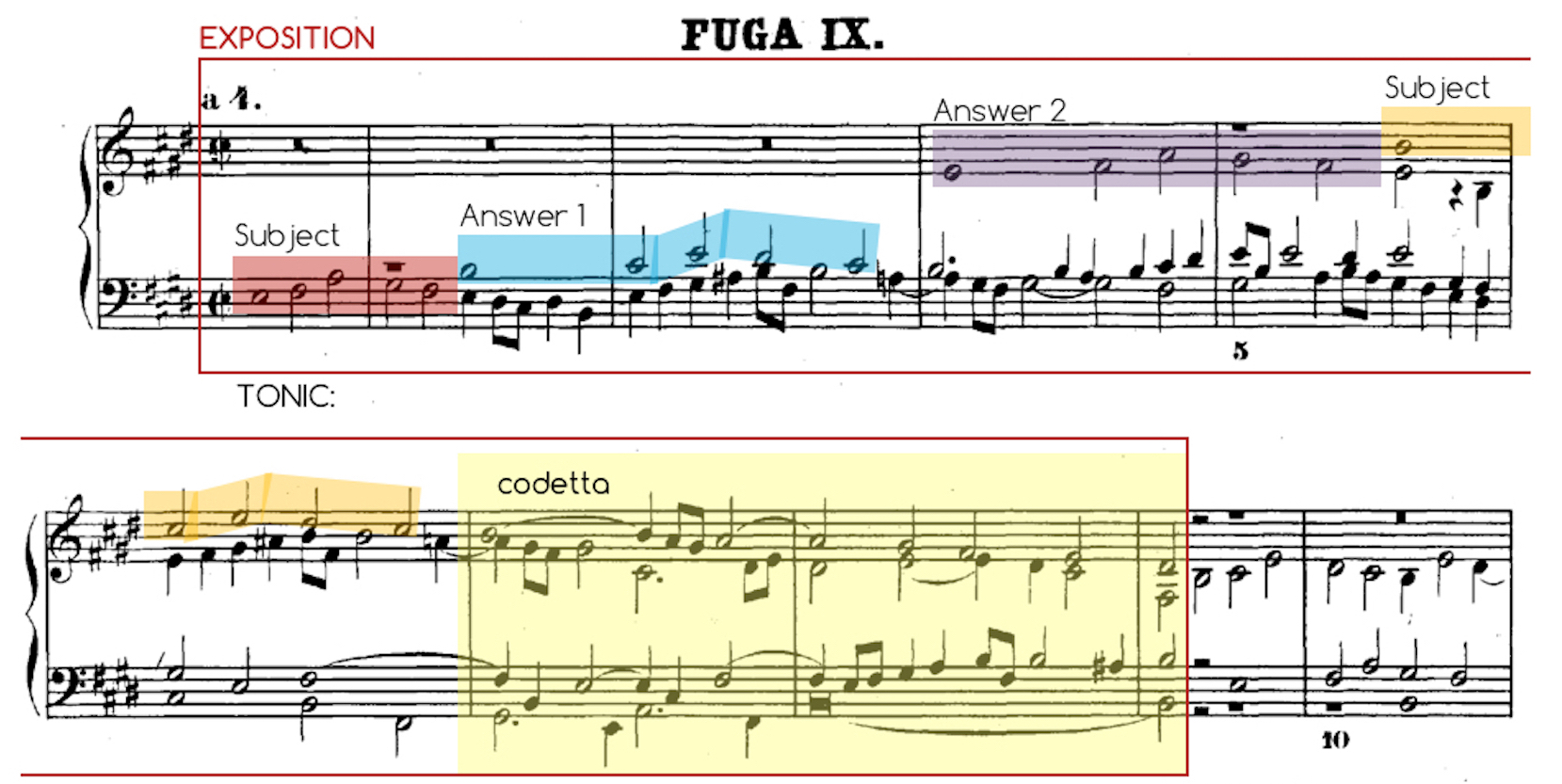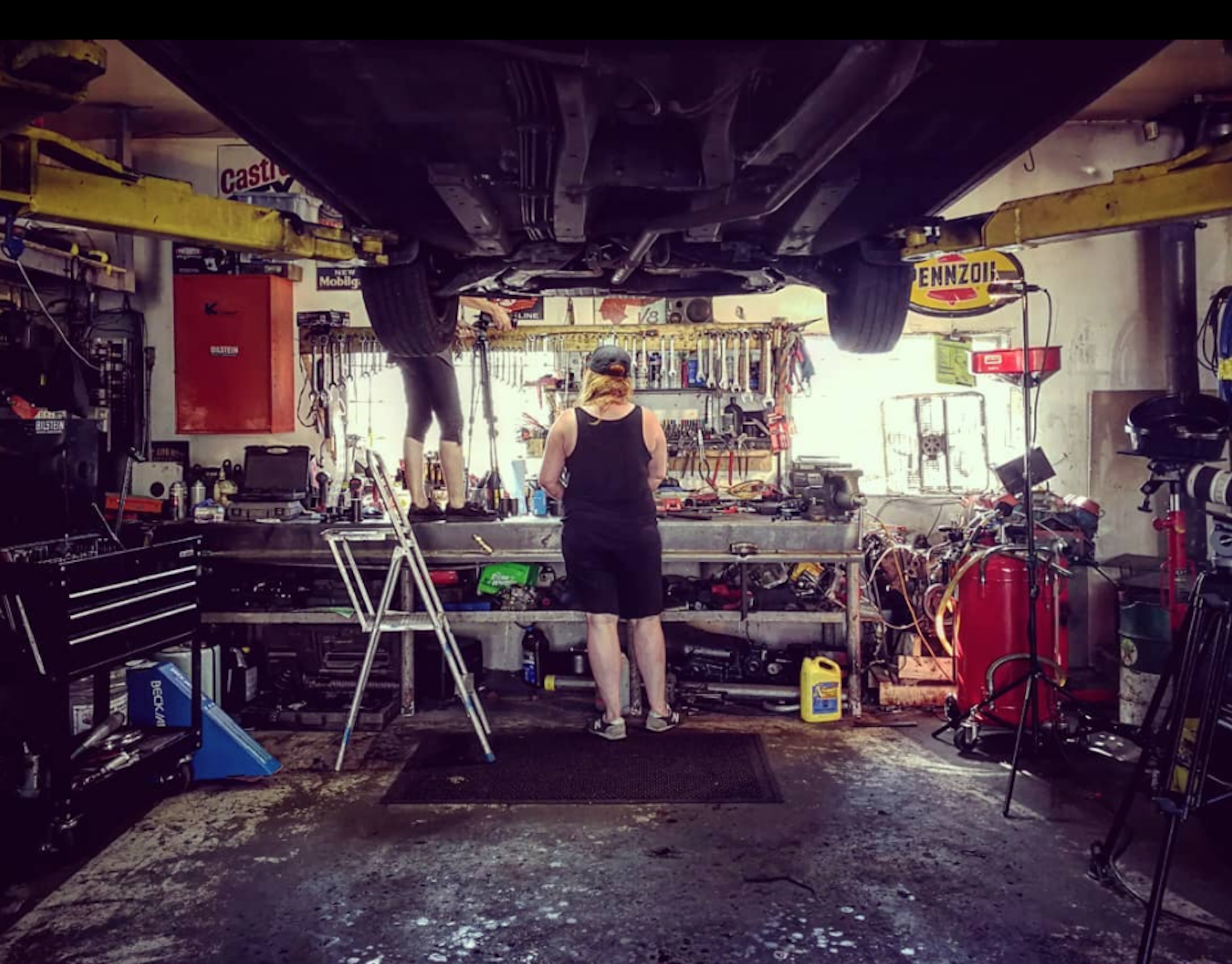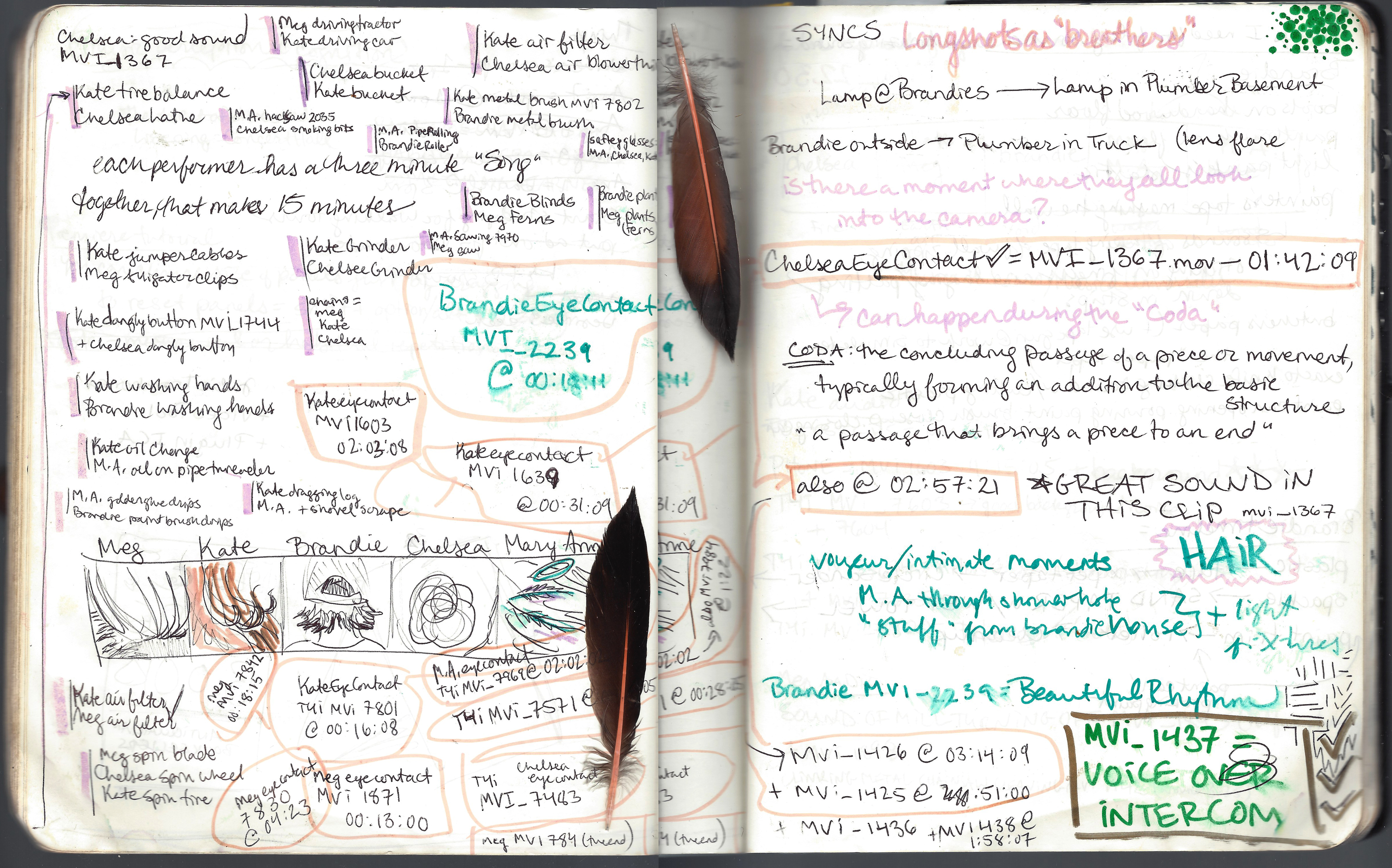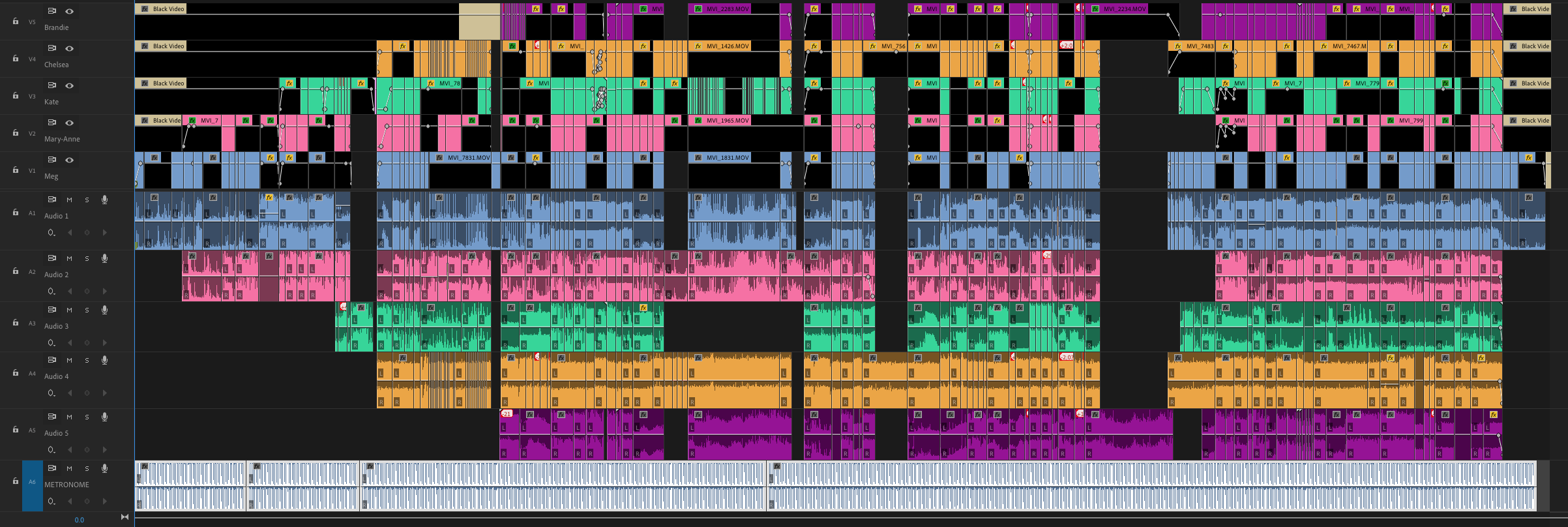A Few Thoughts on Process...
[Fugue: a polyphonic composition in which a short melodic theme, the subject, is introduced by one part or voice, and successively taken up by the others and developed by their interweaving.]

The final page of Contrapunctus XIV (The Unfinished Fugue, 1748) by J.S. Bach

J.S. Bach, fugue #03 in C# major, BWV 848 with analysis, Kimiko Ishizaka
![]()

J.S. Bach; E Major Fugue; Well-Tempered Clavier Book 2
Pre-production
I grew up playing music. My father was a professional orchestral musician, and my mother, an artisan, encouraged the pursuit of creativity. After the passing of my father in 2017, I found myself with a need to produce new work. Trudging through the roadblocks that I had built around myself during my late twenties, I began researching the neuroscience of music, in an attempt to reclaim my musical past, connect to my roots, and create artwork with resonance (literally and metaphorically).
My intentions were to produce a video that took into consideration the musical properties of tone, timbre, contour and rhythm, with the hopes of evoking a visceral response in the viewer. Video, being a time-based medium, inherently embodies some of these qualities, allowing opportunities to use time not only for narrative, but for cadence, tempo and flow.
With a propensity to work in multiple video channels, I began an in-depth study of fugue structure - a compositional technique that features two or more voices built upon a common subject or theme. A traditional fugue gradually builds through the use of repetition and imitation. Drawn to the idea of actions and events occurring simultaneously, I wanted to create an artwork that had multiple voices that came together as a whole.
The imagery of fugue structure that I was uncovering was remarkably similar to the editing timeline in post-production video work. With this in mind, I began making drawings of video timelines and installation ideas in an attempt to understand how I may begin to organize a multi-channel video fugue.
Trade industries and labour jobs have always been of interest to me as an artist. I relate to the act of using your hands to create something. There is a direct connection between the brain and the hands that has always fascinated me. I appreciate the process, investigative aspects and problem-solving within these specific jobs, and find that there is a distinct creative component to tradework that I admire. There is beauty to be found in functionality and repetition.
My decision to feature women working in trade industries stems from a compulsion towards reclamation and redemption that can be seen in many of my artworks over the past ten years. I find myself wanting to highlight subjects that are “unseen” and sometimes under the radar. In addition, I am inspired by the work of women in traditionally male-dominated fields, and the general ‘badassery’ that comes with these associations.

Production Assistant & Camerperson, Sebnem Ozpeta, capturing Katie Stockford’s workbench at Neighbourhood Automotive in Vancouver, BC
Production
Upon receipt of a Concept to Realization grant from the Canada Council for the Arts, the production of The Art of Fugue began in the summer of 2018. After sourcing five tradeswomen in the lower mainland of British Columbia, Canada, as well as a phenomenal production assistant and camerawoman, I embarked on an intuitive journey of documenting five women at work.
Having never worked with storyboards, and not knowing what to expect from the casts’ respective work environments, my assistant and I approached situations with artistic candor. The most creative component to my process has always been in the editing bay, so I knew that as long as I gathered as much footage as possible, I would be able to mold/sculpt/compose the video fugue that I had been seeing in my head.
Each tradeswoman became a great source of inspiration throughout the filming process. Production days became an education in tradework, with insight into the experience of being a woman in a man’s world. The machinist, for example, worked in an all-male production shop, and the arborist worked on an all-male crew. In contrast, the mechanic, the painter, and the plumber all owned their own businesses, with the plumber employing an all-female crew.
After wrapping the shoots in late July of 2018, I came away with a an informed perspective of women in trades, and a tenacious drive to push me into the editing phase of the project.
“A man built this house, I thought to myself. Suddenly I couldn’t wait to get outside, where the moon had filled the potholes with silver. I walked to a tree and sat with my back to it, breathing pine and wet earth.
A man built the road to this cottage. A man drove the grader. Men mined the gravel and processed the tar and built the machines that built the road. It went on and on in a demented version of the House That Jack Built, only this was the entire world - all built, all run, by men. No women.”
- Kate Braid, Journeywoman: Swinging a Hammer in a Man’s World

Organizing footage in my sketchbook, 2018

Colour-coding ideas, 2018
(Meg=Blue; Mary-Anne=Pink; Kate=Light Green; Chelsea=Yellow; Brandie=Purple)

My editing timeline of five channels (+ metronome track) in Premiere Pro, 2019
 Screenshot of final audio waveforms, 2019
Screenshot of final audio waveforms, 2019Post-production
With over 45 hours of footage to work through, I spent the entirety of September, 2018, logging and organizing video files. Working in five channels, and with so much content, was a personal challenge. I created a separate timeline for each cast member. Sifting through hour upon hour of footage, I narrowed the video content down to 1.5 hours per tradeswoman.
Every time that I sat down at my desk to edit, I found myself stuck, with no idea where to start building my fugue. Wrapping my head around the enormous haul of footage was taxing, and trying to organize my ideas concerning the project was like a brain puzzle in itself.
Thus began the process of meticulously watching the footage from each performer, taking detailed notes and colour-coding my annotations with a self-ascribed system of check-marks, hearts and stars. My working notebook is perhaps an artwork in and of itself, as it illustrates the creative process in a curious, adorning way.
My previous video works came to fruition completely in the editing bay, but The Art of Fugue required me to step away from my desk and actually draw. I created several variations of maps and diagrams in an attempt to forge a musical composition. Although I felt a sense of guilt for seemingly taking a break from the literal “editing”, I understood that this was an necessary step of the process.
Post-it Notes became my medium of choice. A large sheet of paper taped to the wall was my canvas. I felt like a detective on a TV show, moving the Post-it Notes around on the sheet of paper, trying to solve the case and find the links between my subjects. Eventually transposing these ideas and adding them to my editing notebook, I returned to my desk (after about two months of detective work), and began the sculptural process of editing five channels simultaneously.
I had always wondered how composers were able to write symphonies with so many instruments and parts... I still wonder. Beethoven heard the music in is head and was somehow able to get it on paper. How can you possibly know what it will sound like until you have an orchestra at your disposal to test things out? Trust. Trust the process. Try your best to evade discouragement. Stop telling yourself that you suck and that it’s pointless. Pray to the editing gods.
Over the next five months, I built, scrapped, reworked, laid foundations and bulldozed entire cities that I had contructed in my editing timeline. I found it helpful to work with a metronome, keeping time in my head and swaying to a beat while I edited. I chose to work with a standard 4/4 time signature at 80 beats per minute, which is a on the higher end of a resting heartrate. Perhaps this kept me on my toes while editing?
Each track was colour-coded to match my Post-it Notes on the wall, so that I could visually see the structure of the fugue in front of me. You can see in the screenshots of my Premiere Pro timelines, that the framework of the video is somewhat akin to the analyses of fugue compostitions.
As a video artist, I often consider the audio and visual tracks to be of equal partners in my work. Both are able to tell stories and evoke a bodily response within the viewer. I rarely use a musical soundtrack in my artwork. My choice to apply a musical format to create The Art of Fugue was in part to conjure a visceral sense within the audience in the way that a sountrack may elicit a similar vibe. I want people to sway, to tap their feet, to feel the rhythm within their bodies.
The Art of Fugue has challenged my methods of creating, and has been the most complex editing work of my career thus far. This project has pushed me into new ways of producing art, from working with multiple performers, to hiring a production assistant and camerawoman, and editing video and sound in five concurrent channels.
- Emilie Crewe
* * * *
 A photo with my dad on his way to work with the Utah Symphony, Salt Lake City, 1989
(Murray Crewe, 1960-2017)
A photo with my dad on his way to work with the Utah Symphony, Salt Lake City, 1989
(Murray Crewe, 1960-2017)In Memorium
Pittsburgh Symphony Brass; “Contrapunctus 1: The Art of Fugue” by J.S. Bach
(featuring my father, Murray Crewe (left), on bass trombone)
(featuring my father, Murray Crewe (left), on bass trombone)
The title, The Art of Fugue, was a way to pay homage to my dad's memory. A well-known incomplete musical work by Johan Sebastian Bach, The Art of Fugue was performed and recorded by the Pittsburgh Symphony Brass in 1998. Adopting this as the title for the video was a nod to my dad, as well as a way to imply the fugue-like structure of my artwork.